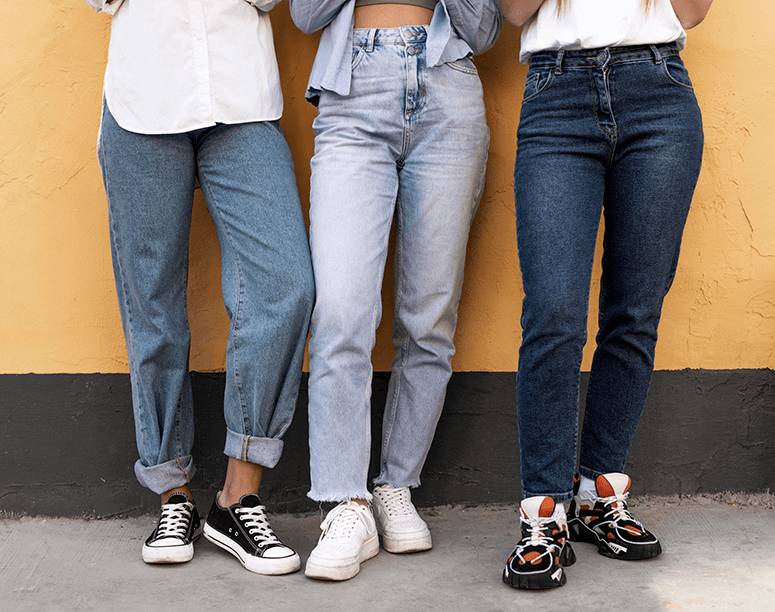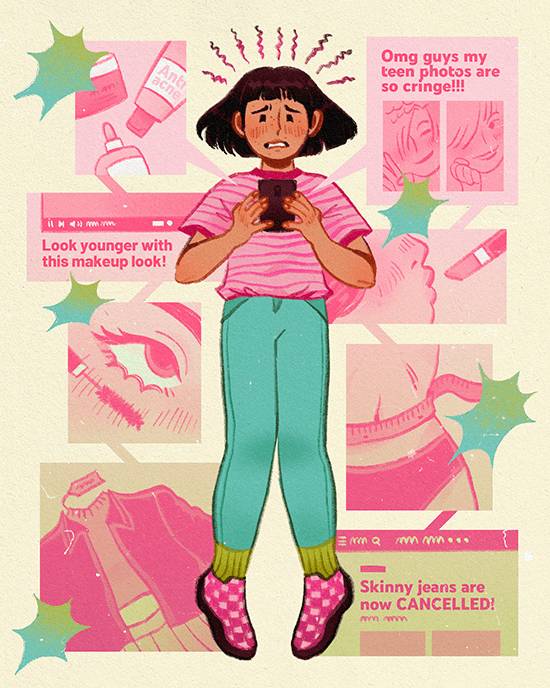Stuck in between: Exploring the need for a tween space
When I was 12 years old, I believed a tucked-in shirt with skinny jeans and a pair of checkered Vans were the trendiest thing I could ever wear. This outfit was the centerpiece of almost all my Instagram posts, as I was fully convinced it was impossible for me to find this embarrassing— until I turned 16.
I cringed at these photos of myself. The cotton spandex shirt was too short to be tucked into my extremely tight jeans. The short bob cut made my already round face even fuller. The prepubescent acne across my t-zone and my buck teeth were clearly visible even without zooming into my face. I immediately archived all my old posts.

Feeling secondhand embarrassment from our younger selves is nothing new, but posting about it online is. In fact, one might already come across the following while scrolling through their feed: twenty-something influencers cringing at their high school outfits; older teenagers mockingly posting videos of their pre-teen selves dressed in outdated fashion and makeup trends; and before-and-after images of people “growing in their features” and losing their baby face as they age.
If my 12-year-old self knew I couldn’t even look at her without feeling disgusted, I can only imagine how hurt she’d feel. But that’s a hypothetical situation. What more for the 12-year-olds now, who watch the whole world, including their online role models, incessantly taunting any ounce of awkwardness typical at their age? The desire to grow up has never seemed more urgent.

The term “tween” originated in the late 1990s, describing children commonly aged eight to 12 in the transitional space of childhood and adolescence, thus existing “in between.” It was first utilized as a marketing niche that usually targeted young girls at the onset of puberty. Natalie Coulter’s Tweening the Girl: the Crystallization of the Tween Market further explains that retail and media industries heavily capitalized on capturing the spending power of tweenagers with disposable income from their opulent families. From Claire’s accessories to tween magazines such as Total Girl and K-Zone, the craze for the tween marketplace was popularized globally, extending to the Philippines throughout the early 2000s to mid-2010s.
Today, tweens are raised by the internet — parented by popular trends and favored influencers who mold their opinions and desires.
As tweenage culture was built upon the grounds of capitalism, its sharp decline was because of those grounds as well. At present, preteen-centered marketing has decreased significantly. With 60 percent of children between the ages of 8 and 12 currently having social media profiles, various consumer brands initially for older clientele have adapted their marketing strategy to also include tweens, often grouping the ages 10-24 into a single demographic. Tweens are bombarded with fear-mongering rhetoric about acne and aging, skincare treatments, and makeup tutorials, often accompanied by the clickable “Yellow Basket.” The ubiquitous nature of these videos makes impressionable preteens believe that this is everything they should desire.
Not only does social media market teenage culture as desirable, but it also diminishes the awkward preteen phase into a cultural pariah that can only be enjoyed satirically. Anything that deviates from acceptable societal norms is regarded as “cringe-worthy,” including the appearances of their younger selves. This could contribute to tweens repressing their desire to experiment—in fear of being judged by their peers or even the brutally contemptuous comments of strangers if they post online. Thus, many are completely averse to indulging in tweenage culture, eager to be perceived as older than they are.

Gen Alpha, the newest generation of tweens, is raised by the internet—parented by popular trends and favored influencers who mold their opinions and desires. This intense pervasiveness could potentially lead to negative consequences that impact their well-being.
Mara Yunsingco, a licensed psychologist and part-time lecturer at the Ateneo De Manila University, explains that tweens are in a critical development phase called “Industry vs. Inferiority,” which is mainly centered on establishing an autonomous identity without the full self-consciousness of adolescence. It is here where preteens explore their preferences, interests, and values to build their self-confidence, laying the foundation for a strong sense of self-efficacy in the long term. However, the immense usage of social media makes tweens vulnerable to the constant evaluations and judgments of other people.
“When I saw these celebrities in magazines as a child, they all possessed similar beauty features. I didn’t fit into that standard, which made me feel bad about myself. However, I knew they were celebrities, so there was always this protective factor that these people are just built to be different. The difference now with social media is that influencers—who are just like you and me—uphold these standards.”
Yusingco further highlights that feelings of inadequacy and inferiority among young people are amplified by the normalization of idealized beauty standards on social media. This could lead to struggles with insecurities and identity formation, as they transition into the Identity vs. Role Confusion phase during adolescence.

There must be greater efforts to address the lack of tween spaces to help preteens form a stronger sense of self. As Yusingco suggests, these spaces could be created as easily as having open discussions between parents and their children regarding online trends. Institutions, such as schools and LGUs, could also create more supportive environments for tweens to engage in constructive activities that allow them to experiment and enhance their personal growth. From my experience, tween-year-old me found her empowering space inside a studio scattered with music sheets, microphones, and groups of three trying to create harmonies. Participating in singing workshops not only allowed me to find my voice, but learn alongside people with similar interests as me. This activity empowered me like nothing else did—and I believe everyone deserves to have this opportunity.
When I was 12 years old, I believed that a tucked-in shirt with skinny jeans and a pair of checkered Vans were the trendiest thing I could ever wear. Even if it didn’t abide by what’s fashionable in the eyes of mainstream trends, it did abide by how I wanted to express myself then. My now 18-year-old self wouldn’t trade that freedom for anything else in the world.


